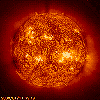| . |  |
. |
 Gazing Through The Sun
Gazing Through The SunTo Forecast The Weather Washington - April 25, 2000 - Scientists have taken a major step forward in their quest to predict space weather, a term covering various events originating on the Sun that can seriously affect communications and electric power transmission lines on Earth and even modify the orbit of satellites. These solar events are expected to increase this year as the Sun approaches solar maximum in its 11-year cycle of sunspot activity. One source of space weather is in fact the sudden increase in sunspot activity, which can potentially change the orbit of satellites. This is caused by increased ultraviolet radiation, which heats Earth's upper atmosphere and changes its density. Large objects like the International Space Station could thereby be moved into new orbits, where they might collide with space debris, whose orbits would also be changing. While all of these orbits can be calculated and satellites maneuvered out of danger, it would clearly help for scientists to have maximum advance knowledge of severe space weather. Writing in the May 1 issue of Geophysical Research Letters, published by the American Geophysical Union, Jean-Loup Bertaux and colleagues at the Service d'Aeronomie of France's Centre National de la Recherche Scientifique, (CNRS) and the Finnish Meteorological Institute (FMI) report a method they have devised of detecting active regions, or sunspots, on the far side of the Sun, before they rotate to its Earthward side. Since the Sun's rotational period is 27 days, this can allow up to two weeks' advance warning of strong solar winds. The technique, described in the GRL paper, is to make use of Lyman alpha radiation, a spectroscopic line in hydrogen atoms floating freely in space. Although the Sun constantly emits Lyman alpha radiation, its active regions can be thought of as projectors, beaming this radiation in stronger and more concentrated streams. Hydrogen atoms in space then function as screens illuminated in their ultraviolet spectrum by the Lyman alpha radiation. Lyman alpha is detected by the SWAN (Solar Wind ANisotropies) instrument aboard the SOHO (SOlar Heliospheric Observatory) satellite, which maintains an apparently fixed position between the Earth and the Sun. SWAN scans the whole sky and is thus able to detect strongly illuminated regions of hydrogen atoms in space beyond the far side of the Sun. By tracking the movement of these strongly illuminated regions, scientists can in effect see around the corner and predict when the sunspots producing strong radiation streams will rotate around and face toward the Earth. This will provide more time to take corrective action in advance of heavy solar weather they may produce. SOHO is a joint mission of ESA and NASA, stationed at 1.5 million kilometers (930,000 miles) from the Earth, near the so-called Lagrange point L1, where the gravity of Earth and Sun balance each other.
SOLARSTORMS AT TERRADAILY.COM
|
| |||||||||
| The content herein, unless otherwise known to be public domain, are Copyright 1995-2016 - Space Media Network. All websites are published in Australia and are solely subject to Australian law and governed by Fair Use principals for news reporting and research purposes. AFP, UPI and IANS news wire stories are copyright Agence France-Presse, United Press International and Indo-Asia News Service. ESA news reports are copyright European Space Agency. All NASA sourced material is public domain. Additional copyrights may apply in whole or part to other bona fide parties. Advertising does not imply endorsement, agreement or approval of any opinions, statements or information provided by Space Media Network on any Web page published or hosted by Space Media Network. Privacy Statement All images and articles appearing on Space Media Network have been edited or digitally altered in some way. Any requests to remove copyright material will be acted upon in a timely and appropriate manner. Any attempt to extort money from Space Media Network will be ignored and reported to Australian Law Enforcement Agencies as a potential case of financial fraud involving the use of a telephonic carriage device or postal service. |